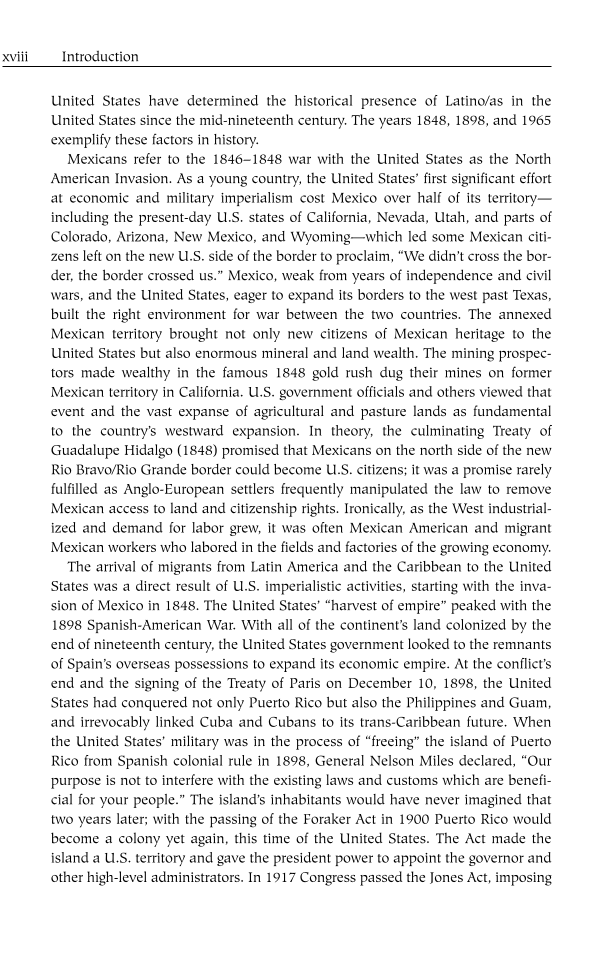United States have determined the historical presence of Latino/as in the United States since the mid-nineteenth century. The years 1848, 1898, and 1965 exemplify these factors in history. Mexicans refer to the 1846–1848 war with the United States as the North American Invasion. As a young country, the United States’ first significant effort at economic and military imperialism cost Mexico over half of its territory— including the present-day U.S. states of California, Nevada, Utah, and parts of Colorado, Arizona, New Mexico, and Wyoming—which led some Mexican citi- zens left on the new U.S. side of the border to proclaim, “We didn’t cross the bor- der, the border crossed us.” Mexico, weak from years of independence and civil wars, and the United States, eager to expand its borders to the west past Texas, built the right environment for war between the two countries. The annexed Mexican territory brought not only new citizens of Mexican heritage to the United States but also enormous mineral and land wealth. The mining prospec- tors made wealthy in the famous 1848 gold rush dug their mines on former Mexican territory in California. U.S. government officials and others viewed that event and the vast expanse of agricultural and pasture lands as fundamental to the country’s westward expansion. In theory, the culminating Treaty of Guadalupe Hidalgo (1848) promised that Mexicans on the north side of the new Rio Bravo/Rio Grande border could become U.S. citizens it was a promise rarely fulfilled as Anglo-European settlers frequently manipulated the law to remove Mexican access to land and citizenship rights. Ironically, as the West industrial- ized and demand for labor grew, it was often Mexican American and migrant Mexican workers who labored in the fields and factories of the growing economy. The arrival of migrants from Latin America and the Caribbean to the United States was a direct result of U.S. imperialistic activities, starting with the inva- sion of Mexico in 1848. The United States’ “harvest of empire” peaked with the 1898 Spanish-American War. With all of the continent’s land colonized by the end of nineteenth century, the United States government looked to the remnants of Spain’s overseas possessions to expand its economic empire. At the conflict’s end and the signing of the Treaty of Paris on December 10, 1898, the United States had conquered not only Puerto Rico but also the Philippines and Guam, and irrevocably linked Cuba and Cubans to its trans-Caribbean future. When the United States’ military was in the process of “freeing” the island of Puerto Rico from Spanish colonial rule in 1898, General Nelson Miles declared, “Our purpose is not to interfere with the existing laws and customs which are benefi- cial for your people.” The island’s inhabitants would have never imagined that two years later with the passing of the Foraker Act in 1900 Puerto Rico would become a colony yet again, this time of the United States. The Act made the island a U.S. territory and gave the president power to appoint the governor and other high-level administrators. In 1917 Congress passed the Jones Act, imposing xviii Introduction
Document Details My Account Print multiple pages
Print
You have printed 0 times in the last 24 hours.
Your print count will reset on at .
You may print 0 more time(s) before then.
You may print a maximum of 0 pages at a time.






























































































































































































































































































































































































































































































































































































































































































































































































































































































































































































































